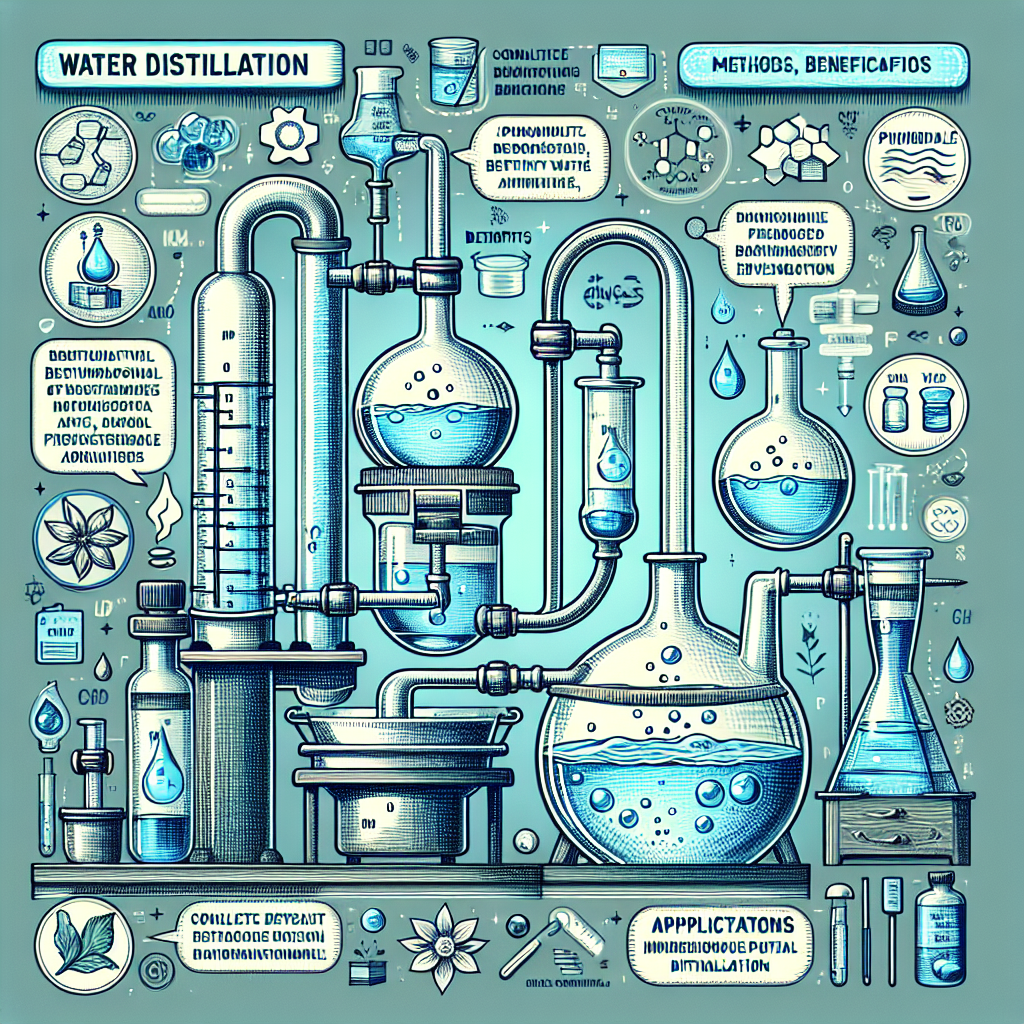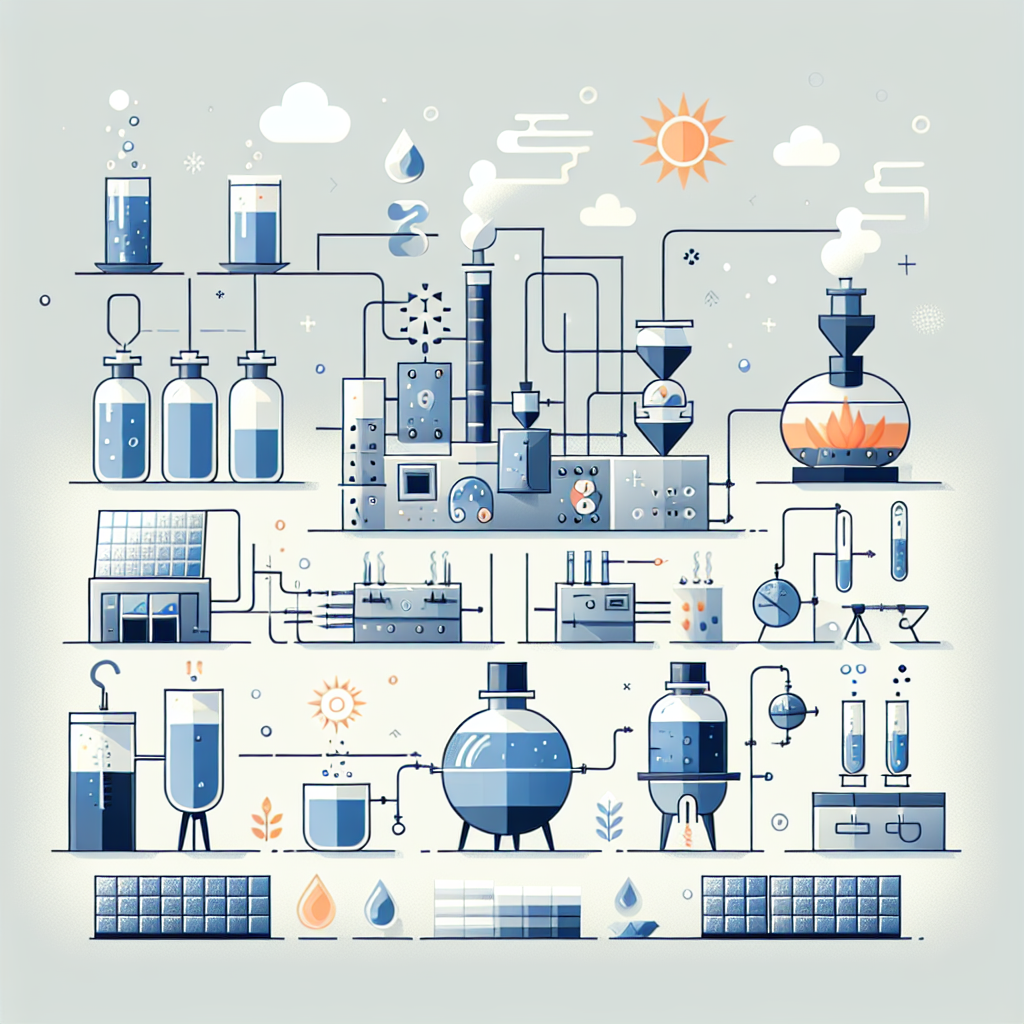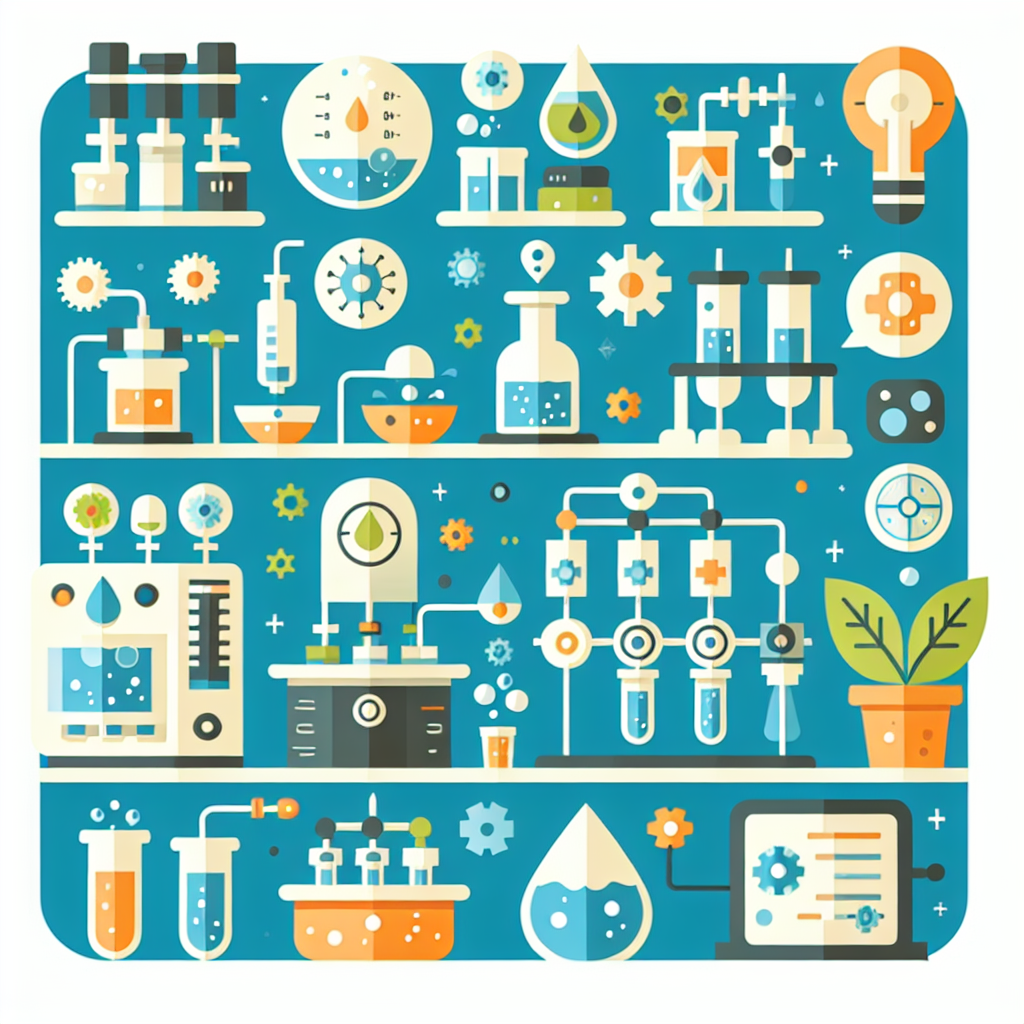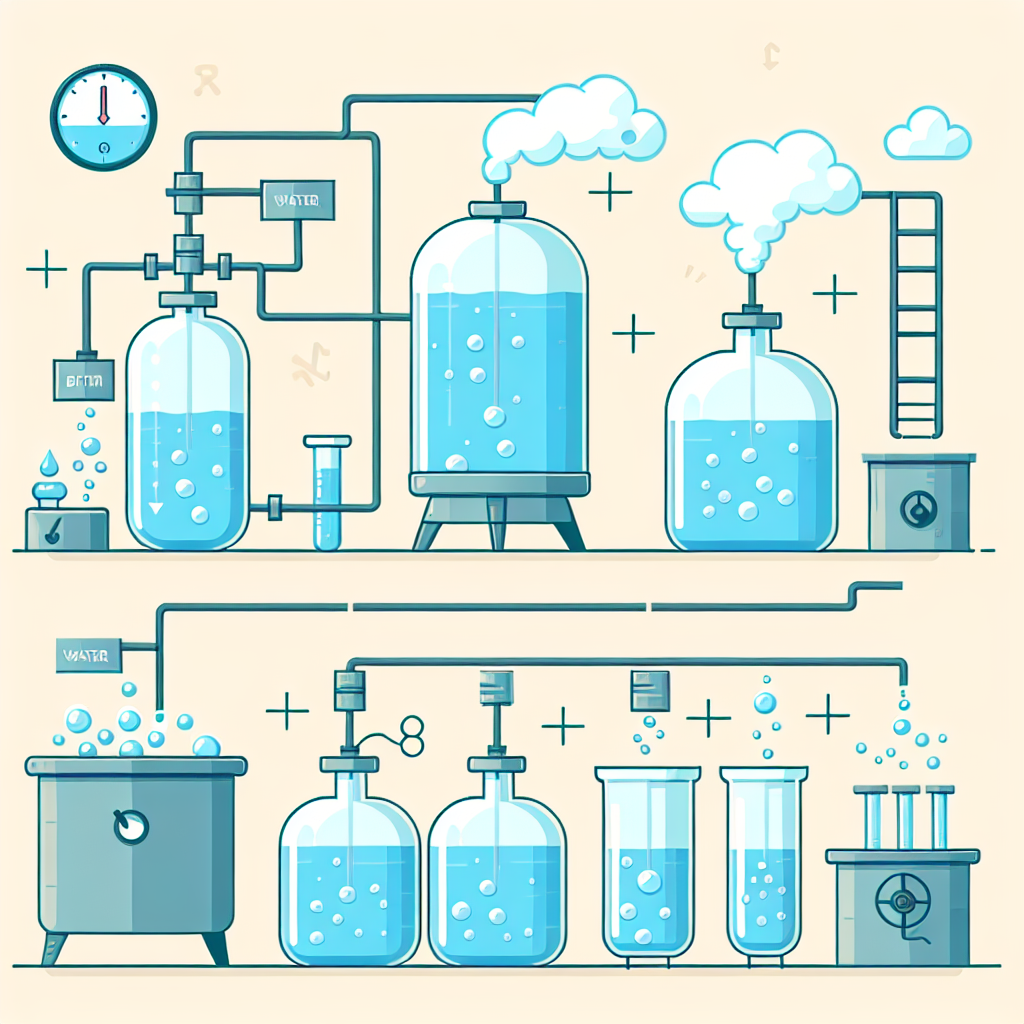Complete Guide to Water Distillation: Methods, Benefits and Applications

Complete Guide to Water Distillation: Methods, Benefits and Applications
Introduction
Welcome to the Complete Guide to Water Distillation! If you’ve ever wondered about the distillation of water, you’re in the right place. This guide is designed to unravel the mysteries behind this fascinating water purification process, exploring not just how it works, but also why it matters.
Imagine a world where you could transform ordinary tap water into a pristine elixir, free from impurities and contaminants. Well, that’s exactly what the water distillation method does! From its humble beginnings to its modern-day applications in both homes and industries, distillation has become a cornerstone of effective water treatment.
In this guide, we’ll dive deep into the various methods of distilled water production, comparing it with other purification techniques like reverse osmosis vs distillation. We’ll highlight the numerous advantages of water distillation spoiler alert: it’s not just about being fancy! Plus, we’ll cover practical tips for those interested in making distilled water at home or understanding industrial processes.
So whether you’re an engineer looking for efficient solutions, a wastewater treatment operator seeking innovative methods, or simply someone curious about how to ensure clean drinking water, stick around. We promise you’ll walk away with valuable insights into the world of distilled water!

Understanding the Distillation of Water
The distillation of water is like giving your H2O a luxurious spa treatment. This process involves heating water to its boiling point, allowing it to evaporate, and then cooling it down to collect the purified liquid. Essentially, it’s a fancy way to separate water from impurities, making it one of the most effective water purification processes out there.
Definition and Overview
At its core, the distillation of water is a water distillation method that capitalizes on the differences in boiling points between water and contaminants. When you boil water, all those pesky impurities like salts, heavy metals, and microorganisms are left behind. The steam rises and is then condensed back into liquid form, resulting in what we call distilled water.
History of Water Distillation
The roots of this technique can be traced back to ancient civilizations. The earliest recorded use dates back over 2000 years ago when Greeks and Romans employed simple distillation techniques for various applications including medicinal purposes. Fast forward to today, and we see the evolution of this method into both home setups with a home water distiller and large-scale operations in industrial settings.
Did You Know? Modern advancements have made the efficiency of water distillers skyrocket! Today’s systems can produce laboratory-grade distilled water that meets stringent quality standards.
The Science Behind It
The magic happens during two key phases: boiling and condensation. During the boiling process in distillation, impurities remain in the original container while vapor rises. This vapor is then cooled often using coils or condensers to transform back into liquid form. This simple yet effective mechanism ensures that what you end up with is free from most contaminants.
Common Applications
- Bottled Distilled Water: Often seen as a premium choice for drinking due to its purity.
- Laboratory-Grade Distilled Water: Essential for experiments where even minor contamination can skew results.
- Medical Use: Used in various medical devices such as CPAP machines to prevent mineral build-up.
- Culinary Uses: Chefs often prefer distilled water for cooking as it allows flavors to shine without interference from minerals.
This method may sound straightforward but don’t underestimate its power! The advantages of water distillation extend beyond just removing impurities; it’s also an eco-friendly way to purify drinking water without relying on harsh chemicals. So whether you’re considering a home setup or looking into industrial applications, understanding how to distill water can open up a world of possibilities for cleaner hydration.
If you’re curious about how this compares with other methods like reverse osmosis or filtration systems stay tuned! We’ll dive deeper into those comparisons in upcoming sections!
Water Purification Process: An Overview
When it comes to ensuring the safety of our drinking water, understanding the water purification process is crucial. Among various methods, the distillation of water stands out as a reliable technique for producing clean and safe water.
The global market size for water purification systems was valued at USD 71.45 billion in 2022, indicating a growing awareness and demand for effective water treatment solutions.
Types of Water Purification Methods
Water purification methods can be broadly classified into several categories:
- Physical Methods: Includes filtration and sedimentation.
- Chemical Methods: Involves the use of chlorine, ozone, or other chemicals to disinfect water.
- Biosorption: Utilizes natural materials to remove contaminants.
- Distillation: A method that involves boiling water to produce steam and then condensing it back into liquid form, effectively removing impurities.
Comparison with Other Methods (Filtration, Reverse Osmosis)
The choice of purification method can significantly impact both efficiency and effectiveness. Here’s how distillation stacks up against other popular techniques:
| Method | Efficiency | Cost | Removal of Impurities |
|---|---|---|---|
| Distillation | High | $ (Higher initial investment) | 99%+ |
| Filtration | Moderate | $ (Lower initial cost) | 70%-90% |
| Reverse Osmosis | High | $ (Moderate initial investment) | 95%-99% |
The table above highlights that while distillation may require a higher upfront cost and energy consumption, its ability to remove contaminants makes it an excellent choice for producing high-quality distilled water. Moreover, understanding these differences can help municipalities and engineers select the most appropriate method for their specific needs.
No matter which method you choose, being informed about the options available in the water purification process is essential. As we dive deeper into the specifics of the distillation of water in upcoming sections, you’ll see why it’s often favored for applications requiring purity like laboratory-grade distilled water or medical uses!
Water Distillation Method Explained
The distillation of water is like a magic trick for purifying H2O. It’s a simple yet effective water purification process that involves boiling water and then collecting the steam, which leaves impurities behind. Think of it as the ultimate separation act!
Boiling Process in Distillation
The adventure begins with the boiling process in distillation. When you heat water, it reaches its boiling point, transforming into steam. This steam is not just hot air it’s your ticket to pure water! As the water boils, contaminants such as salts, minerals, and bacteria are left behind in the boiling chamber.
Condensation in Water Distillation
Next up is condensation in water distillation. After the steam escapes, it travels through a cooling system where it condenses back into liquid form. Voilà! You’ve got distilled water! This step is crucial because it ensures that any remaining impurities are left behind while you collect clean, distilled water.
Types of Water Distillation Techniques
There are several techniques for distilled water production, each with its unique flair:
- Steam Distillation of Water: Commonly used in industrial settings, this method employs steam to extract essential oils and purify large quantities of water.
- Solar Water Distillation: An eco-friendly approach that uses sunlight to heat water and create steam perfect for those sunny days when you want to harness nature’s power!
- Industrial Water Distillation Processes: These are large-scale operations designed for high efficiency and output, often utilizing advanced technology to maximize purity and minimize costs.
Did You Know? The efficiency of water distillers can vary significantly based on the method used. For instance, solar distillers may take longer but are incredibly eco-friendly!
The beauty of these methods lies in their versatility. Whether you’re looking at home setups or large-scale industrial applications, understanding how to distill water opens up a world of possibilities for clean drinking options.
Ultimately, the choice between methods like reverse osmosis vs distillation often comes down to specific needs cost considerations, efficiency levels, and even personal preference play significant roles.
The distillation process is one of the oldest forms of purification known to humankind.
Advantages of Water Distillation
When it comes to the distillation of water, the benefits are as clear as a freshly distilled glass! Let’s dive into some of the standout advantages that make this method a go-to for both home and industrial applications.
Removal of Impurities from Water
The primary goal of any water purification process is to eliminate contaminants, and water distillation does this like a champ. By boiling water and then condensing the steam back into liquid form, distillation effectively separates impurities such as:
- Heavy metals (like lead and mercury)
- Bacteria and viruses
- Chlorine and other volatile chemicals
- Minerals that may affect taste or cause scale buildup in appliances
This makes distilled water an excellent choice for those seeking pure hydration or for applications requiring laboratory-grade quality.
Chemical-Free Purification Method
One of the best parts about the water distillation method? It’s a chemical-free purification approach! Unlike some methods that use filters which may leach chemicals over time or involve added substances, distillation relies solely on heat. This means you get pure H2O without any unwanted extras. It’s like making your own clean slate no additives, just good old-fashioned science!
Efficiency of Water Distillers and Cost Considerations
Now let’s talk turkey or rather, costs. While investing in a home water distiller might seem pricey upfront, consider it an investment in your health and peace of mind. The efficiency of modern distillers has improved dramatically, meaning you can produce distilled water at home without breaking the bank.
Key Takeaway: A typical home distiller can produce about 1 gallon of distilled water in 4-6 hours. If you’re consuming bottled distilled water frequently, your home setup could pay for itself in just a few months!
A Versatile Solution for Various Needs
The versatility of distilled water is another feather in its cap. Whether you’re using it for:
- Your morning coffee (hello, flavor!)
- Aquariums needing pristine conditions
- Sensitive lab experiments requiring purity
- Beverage production where taste matters (think craft brewing!)
The efficiency of industrial water distillation processes can yield large quantities of distilled water while maintaining low operational costs.
The bottom line? The advantages of water distillation go beyond mere purification; they touch on health, efficiency, and versatility. So whether you’re considering a home setup or looking into industrial applications, understanding these benefits will help you make informed decisions about your hydration needs.
Benefits of Distilled Water in Various Applications
Distilled water is more than just a fancy term for H2O; it’s a superstar in various fields! From medical settings to industrial applications, the benefits of distilled water are as vast as a summer sky. Let’s dive into the refreshing world of distilled water and explore its many uses.
1. Medical Use of Distilled Water
In the medical field, distilled water is like that dependable friend who always shows up when you need them. It’s used in:
- Sterilization: Essential for cleaning surgical instruments and laboratory equipment, ensuring no impurities interfere with procedures.
- IV Solutions: Many intravenous solutions use distilled water as a base to avoid any unwanted contaminants.
- Medical Devices: Humidifiers and CPAP machines benefit from distilled water to prevent mineral buildup and ensure patient safety.
2. Bottled Distilled Water Brands Comparison
If you’re in the market for bottled distilled water, it’s crucial to know what brands deliver quality. Here’s a quick comparison:
| Brand | Source | Price per Liter | Notes |
|---|---|---|---|
| Aquafina | Purified using reverse osmosis |
Benefits of Distilled Water in Various Applications
.89 |
Crisp taste, widely available |
| Smartwater | Vapor-distilled with electrolytes added | .20 | Smooth flavor, premium branding |
| DASANI | Purified with minerals added for taste |
Benefits of Distilled Water in Various Applications
.99 |
A popular choice but not true distilled water! |
3. Uses of Distilled Water in Industry and Laboratories
The industrial world loves distilled water! Its purity makes it an ideal choice for various applications:
- Chemical Reactions: In laboratories, it ensures that reactions are not affected by impurities.
- Cooling Systems: Used in cooling towers to prevent scaling and corrosion.
- Manufacturing Processes: Essential in producing electronics where even tiny impurities can lead to defects.
If you’re considering incorporating distilled water into your operations or daily life, now’s the time! Explore options like investing in a home water distiller or checking out local bottled brands.
Makeshift Home Solutions: How to Distill Water at Home?
- Making Distilled Water at Home: Step-by-Step Guide li >
- Maintenance of a Home Distiller Machine li >
ul >
section >Drinking Distilled Water: Safety and Considerations h2 >
- Drinking Distilled vs Purified Water li >
- Disadvantages of Drinking Distilled Water Regularly li >
ul >
section >
section >
section >article blockquote,article ol li,article p,article ul li{font-family:inherit;font-size:18px}.featuredimage{height:300px;overflow:hidden;position:relative;margin-top:20px;margin-bottom:20px}.featuredimage img{width:100%;height:100%;top:50%;left:50%;object-fit:cover;position:absolute;transform:translate(-50%,-50%)}article p{line-height:30px}article ol li,article ul li{line-height:30px;margin-bottom:15px}article blockquote{border-left:4px solid #ccc;font-style:italic;background-color:#f8f9fa;padding:20px;border-radius:5px;margin:15px 10px}article div.info-box{background-color:#fff9db;padding:20px;border-radius:5px;margin:15px 0;border:1px solid #efe496}article table{margin:15px 0;padding:10px;border:1px solid #ccc}article div.info-box p{margin-bottom:0;margin-top:0}article span.highlight{background-color:#f8f9fb;padding:2px 5px;border-radius:5px}article div.info-box span.highlight{background:0 0!important;padding:0;border-radius:0}article img{max-width:100%;margin:20px 0}





